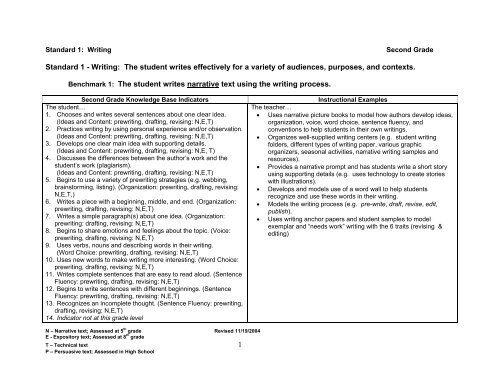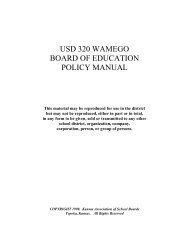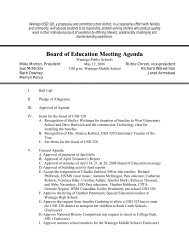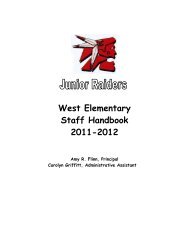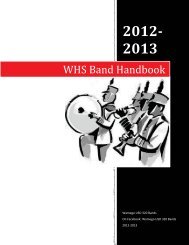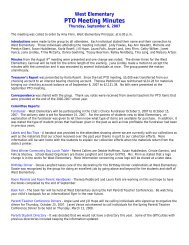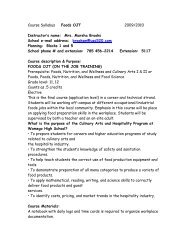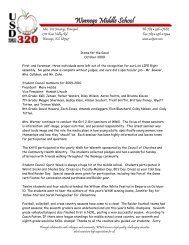1 Standard 1 - Writing: The student writes effectively for a ... - USD 320
1 Standard 1 - Writing: The student writes effectively for a ... - USD 320
1 Standard 1 - Writing: The student writes effectively for a ... - USD 320
Create successful ePaper yourself
Turn your PDF publications into a flip-book with our unique Google optimized e-Paper software.
<strong>Standard</strong> 1: <strong>Writing</strong> Second Grade<br />
<strong>Standard</strong> 1 - <strong>Writing</strong>: <strong>The</strong> <strong>student</strong> <strong>writes</strong> <strong>effectively</strong> <strong>for</strong> a variety of audiences, purposes, and contexts.<br />
Benchmark 1: <strong>The</strong> <strong>student</strong> <strong>writes</strong> narrative text using the writing process.<br />
Second Grade Knowledge Base Indicators<br />
<strong>The</strong> <strong>student</strong>…<br />
1. Chooses and <strong>writes</strong> several sentences about one clear idea.<br />
(Ideas and Content: prewriting, drafting, revising: N,E,T)<br />
2. Practices writing by using personal experience and/or observation.<br />
(Ideas and Content: prewriting, drafting, revising: N,E,T)<br />
3. Develops one clear main idea with supporting details.<br />
(Ideas and Content: prewriting, drafting, revising: N,E, T)<br />
4. Discusses the differences between the author’s work and the<br />
<strong>student</strong>’s work (plagiarism).<br />
(Ideas and Content: prewriting, drafting, revising: N,E,T)<br />
5. Begins to use a variety of prewriting strategies (e.g. webbing,<br />
brainstorming, listing). (Organization: prewriting, drafting, revising:<br />
N,E,T,)<br />
6. Writes a piece with a beginning, middle, and end. (Organization:<br />
prewriting, drafting, revising: N,E,T)<br />
7. Writes a simple paragraph(s) about one idea. (Organization:<br />
prewriting: drafting, revising: N,E,T)<br />
8. Begins to share emotions and feelings about the topic. (Voice:<br />
prewriting, drafting, revising: N,E,T)<br />
9. Uses verbs, nouns and describing words in their writing.<br />
(Word Choice: prewriting, drafting, revising: N,E,T)<br />
10. Uses new words to make writing more interesting. (Word Choice:<br />
prewriting, drafting, revising: N,E,T)<br />
11. Writes complete sentences that are easy to read aloud. (Sentence<br />
Fluency: prewriting, drafting, revising: N,E,T)<br />
12. Begins to write sentences with different beginnings. (Sentence<br />
Fluency: prewriting, drafting, revising: N,E,T)<br />
13. Recognizes an incomplete thought. (Sentence Fluency: prewriting,<br />
drafting, revising: N,E,T)<br />
14. Indicator not at this grade level<br />
Instructional Examples<br />
<strong>The</strong> teacher…<br />
Uses narrative picture books to model how authors develop ideas,<br />
organization, voice, word choice, sentence fluency, and<br />
conventions to help <strong>student</strong>s in their own writings.<br />
Organizes well-supplied writing centers (e.g. <strong>student</strong> writing<br />
folders, different types of writing paper, various graphic<br />
organizers, seasonal activities, narrative writing samples and<br />
resources).<br />
Provides a narrative prompt and has <strong>student</strong>s write a short story<br />
using supporting details (e.g. uses technology to create stories<br />
with illustrations).<br />
Develops and models use of a word wall to help <strong>student</strong>s<br />
recognize and use these words in their writing.<br />
Models the writing process (e.g. pre-write, draft, revise, edit,<br />
publish).<br />
Uses writing anchor papers and <strong>student</strong> samples to model<br />
exemplar and “needs work” writing with the 6 traits (revising &<br />
editing)<br />
N – Narrative text; Assessed at 5 th grade Revised 11/19/2004<br />
E - Expository text; Assessed at 8 th grade<br />
T – Technical text 1<br />
P – Persuasive text; Assessed in High School
15. Uses correct spacing between words. (Conventions: prewriting,<br />
drafting, revising: N,E,T<br />
16. Capitalizes the beginning of a sentence and uses correct end<br />
punctuation. (Conventions: prewriting, drafting, revising: N,E,T)<br />
17. Uses correct subject/verb agreement and verb tenses.<br />
(Conventions: prewriting, drafting, revising: N,E,T)<br />
18. Correctly spells high frequency words. (Conventions: prewriting,<br />
drafting, revising: N,E,T)<br />
19. Attempts paragraph divisions. (Conventions: prewriting, drafting,<br />
revising: N,E,T)<br />
(<strong>The</strong> instructional examples provided in this document are only examples of teaching<br />
strategies and are not intended to endorse any one specific idea or concept. <strong>The</strong>se<br />
examples should not be used exclusively <strong>for</strong> instruction.)<br />
Teacher Notes:<br />
N – Narrative text; Assessed at 5 th grade Revised 11/19/2004<br />
E - Expository text; Assessed at 8 th grade<br />
T – Technical text 2<br />
P – Persuasive text; Assessed in High School
<strong>Standard</strong> 1: <strong>Writing</strong> Second Grade<br />
<strong>Standard</strong> 1 - <strong>Writing</strong>: <strong>The</strong> <strong>student</strong> <strong>writes</strong> <strong>effectively</strong> <strong>for</strong> a variety of audiences, purposes, and contexts.<br />
Benchmark 2: <strong>The</strong> <strong>student</strong> <strong>writes</strong> expository text using the writing process.<br />
Second Grade Knowledge Base Indicators<br />
<strong>The</strong> <strong>student</strong>…<br />
1. Chooses and <strong>writes</strong> several sentences about one clear idea.<br />
(Ideas and Content: prewriting, drafting, revising: N,E,T)<br />
2. Develops one clear main idea with supporting details.<br />
(Ideas and Content: prewriting, drafting, revising: N,E,T)<br />
3. Writes by using personal experience and/or observations to<br />
provide in<strong>for</strong>mation from varied resources. (Ideas and Content:<br />
prewriting, drafting, revising: N,E,T)<br />
4. Expresses in<strong>for</strong>mation in own words using complete sentences.<br />
(Ideas and Content: prewriting, drafting, revising: N,E,T)<br />
5. Discusses the differences between the author’s work and the<br />
<strong>student</strong>’s work (plagiarism). (Ideas and Content: prewriting,<br />
drafting, revising: N,E,T)<br />
6. Gives credit to the author, title, or Web site. (Ideas and Content:<br />
prewriting, drafting, revising: N,E,T)<br />
7. Indicator not at this grade level<br />
8. Begins to use a variety of prewriting strategies (e.g. webbing,<br />
brainstorming, listing). (Organization: prewriting, drafting, revising:<br />
N,E,T)<br />
9. Writes a piece with a beginning, middle, and end. (Organization:<br />
prewriting, drafting, revising: N,E,T)<br />
10. Writes a simple paragraph(s) about one idea. (Organization:<br />
prewriting, drafting, revising: N,E,T)<br />
11. Begins to use transitions to allow ideas to flow smoothly within the<br />
writing piece. (Organization: prewriting, drafting, revising: N,E,T)<br />
12. Writes feelings and thoughts about the topic with the purpose of<br />
in<strong>for</strong>ming the reader. (Voice: prewriting, drafting, revising: N,E,T)<br />
13. Uses nouns, verbs, and describing words in their writing. (Word<br />
Choice: prewriting, drafting, revising: N,E,T)<br />
Instructional Examples<br />
<strong>The</strong> teacher…<br />
Develops with <strong>student</strong>s, a revising/editing checklist.<br />
Provides and uses expository picture books and/or other<br />
resources to model the use of meaning and sequential order (e.g.<br />
identifies author’s purpose and expository text structures).<br />
Uses expository picture books to model how authors develop the 6<br />
traits to help <strong>student</strong>s in their own writings.<br />
Organizes well-supplied writing centers (e.g. <strong>student</strong> writing<br />
folders, different types of writing paper, various graphic<br />
organizers, seasonal activities, expository writing samples and<br />
resources).<br />
Directs <strong>student</strong>s to use pictures from an expository book or<br />
sequencing cards and write about the pictures.<br />
Develops and models use of a word wall to help <strong>student</strong>s<br />
recognize and use these words in their writing.<br />
Provides an expository prompt or <strong>student</strong> self selected topics and<br />
has <strong>student</strong>s write using factual supporting details (e.g. uses<br />
technology to create writings).<br />
Directs <strong>student</strong>s to develop simple reports.<br />
N – Narrative text; Assessed at 5 th grade Revised 11/19/2004<br />
E - Expository text; Assessed at 8 th grade<br />
T – Technical text 3<br />
P – Persuasive text; Assessed in High School
14. Uses new words to make writing more interesting. (Word Choice:<br />
prewriting, drafting, revising: N,E,T)<br />
15. Writes complete sentences that are easy to read aloud. (Sentence<br />
Fluency: prewriting, drafting, revising: N,E,T)<br />
16. Write sentences with different beginnings. (Sentence Fluency:<br />
prewriting, drafting, revising: N,E,T)<br />
17. Recognizes an incomplete thought. (Sentence Fluency: prewriting,<br />
drafting, revising: N,E,T)<br />
18. Uses correct spacing between words. (Conventions: prewriting,<br />
drafting, revising: N,E,T)<br />
19. Capitalizes the beginning of a sentence using correct punctuation.<br />
(Conventions: prewriting, drafting, revising: N,E,T)<br />
20. Uses correct subject/verb agreement and verb tense.<br />
(Conventions: prewriting, drafting, revising: N,E,T)<br />
21. Correctly spells high frequency words. (Conventions: prewriting,<br />
drafting, revising: N,E,T)<br />
22. Attempts paragraph divisions. (Conventions: prewriting, drafting,<br />
revising: N,E,T)<br />
(<strong>The</strong> instructional examples provided in this document are only examples of teaching<br />
strategies and are not intended to endorse any one specific idea or concept. <strong>The</strong>se<br />
examples should not be used exclusively <strong>for</strong> instruction.)<br />
Teacher Notes:<br />
N – Narrative text; Assessed at 5 th grade Revised 11/19/2004<br />
E - Expository text; Assessed at 8 th grade<br />
T – Technical text 4<br />
P – Persuasive text; Assessed in High School
<strong>Standard</strong> 1: <strong>Writing</strong> Second Grade<br />
<strong>Standard</strong> 1 – <strong>Writing</strong>: <strong>The</strong> <strong>student</strong>s write <strong>effectively</strong> <strong>for</strong> a variety of audiences, purposes, and contexts.<br />
Benchmark 3: <strong>The</strong> <strong>student</strong> <strong>writes</strong> technical text using the writing process.<br />
Second Grade Knowledge Base Indicators<br />
<strong>The</strong> <strong>student</strong>…<br />
1. Chooses and <strong>writes</strong> several sentences or phrases about one clear<br />
idea. (Ideas and Content: prewriting, drafting, revising: N,E,T)<br />
2. Uses supporting details, which helps to clarify the main idea.<br />
(Ideas and Content: prewriting, drafting, revising: N,E,T)<br />
3. Discusses the differences between the author’s work and the<br />
<strong>student</strong>’s work (plagiarism). (Ideas and Content: prewriting,<br />
drafting, revising: N,E,T)<br />
4. Indicator not at this grade level<br />
5. Indicator not at this grade level<br />
6. Begins to use a variety of prewriting strategies (e.g. webbing,<br />
brainstorming, listing). (Organization: prewriting, drafting, revising:<br />
N,E,T)<br />
7. Writes a simple statement(s) or list(s) about one<br />
idea.(Organization: prewriting, drafting, revising: N,E,T)<br />
8. Writes a piece in sequential order. (Organization: prewriting,<br />
drafting, revising: N,E,T)<br />
9. Begins to use simple transitions (e.g. first, second, third, finally).<br />
(Organization: prewriting, drafting, revising: N,E,T)<br />
10. Begins to write with an awareness of purpose and audience (e.g.<br />
letters, simple reports, and/or directions). (Voice: prewriting,<br />
drafting, revising: N,E,T)<br />
11. Indicator not at this grade level<br />
12. Chooses words that are reasonably accurate and makes the<br />
message clear (e.g. technical terms). (Word Choice: prewriting,<br />
drafting, revising: N,E,T)<br />
13. Indicator not at this grade level<br />
14. Writes sentences or phrases that are easy to read aloud.<br />
(Sentence Fluency: prewriting, drafting, revising: N,E,T)<br />
15. Capitalizes the beginning of a sentence and uses correct<br />
N – Narrative text; Assessed at 5 th grade Revised 11/19/2004<br />
E - Expository text; Assessed at 8 th grade<br />
T – Technical text 5<br />
P – Persuasive text; Assessed in High School<br />
Instructional Examples<br />
<strong>The</strong> teacher…<br />
Models and directs <strong>student</strong>s to write simple directions (e.g. make<br />
a sandwich, directions to somewhere, how to . . .).<br />
Models and directs the creation of a simple friendly letter.<br />
Develops with <strong>student</strong>s, a revising/editing checklist.<br />
Uses technical text to illustrate the text structure of technical<br />
writing (e.g. create a job description <strong>for</strong> an elf, a leprechaun, a<br />
teacher, a principal, a mother, a father, a friend).<br />
Models and instructs <strong>student</strong>s on how to explain their thinking on a<br />
process in math (district’s focus question or problem solving).
punctuation. (Conventions: prewriting, drafting, revising: N,E,T)<br />
16. Uses correct grammar when writing sentences or phrases.<br />
(Conventions: prewriting, drafting, revising: N,E,T)<br />
17. Uses correct spelling even with more difficult words. (Conventions:<br />
prewriting, drafting, revising: N,E,T)<br />
18. Uses graphic devices (e.g. tables, graphs, maps, other text<br />
features). (Conventions: prewriting, drafting, revising: T)<br />
Teacher Notes:<br />
(<strong>The</strong> instructional examples provided in this document are only examples of teaching<br />
strategies and are not intended to endorse any one specific idea or concept. <strong>The</strong>se<br />
examples should not be used exclusively <strong>for</strong> instruction.)<br />
N – Narrative text; Assessed at 5 th grade Revised 11/19/2004<br />
E - Expository text; Assessed at 8 th grade<br />
T – Technical text 6<br />
P – Persuasive text; Assessed in High School


